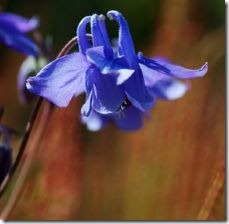A columbine flower can be one of over 50 members of the genus Aquilegia, and is from the family Ranunculaceae. The columbine grows in Asia, Europe and North America, where it is the Colorado state flower. As an ornamental, the columbine varieties are popular because they can be nearly any color. And for the bird watcher, the columbine is a favorite of hummingbirds.
Types
-
Common representatives of the columbine variety include the red (Aquilegia canadensis), yellow (Aquilegia flavescens), European (Aquilegia vulgaris) and Western (Aquilegia formosa). There is also a Colorado blue species (Aquilegia coerulea), which has two varieties: Colorado alpine and another Colorado blue.
Features
-
The height of a mature columbine flower can vary between 10 to 30 inches, with 24 inches being the average. The stem of the plant extends into the ground 1 to 2 inches before the root structure begins. The stem is cylindrical and varies in color from light-green to green to greenish/purplish-brown. Each type of columbine produces downward-facing flowers which have a tubular body. Most types are designated by the color of the flower’s body, but within the upper tubular portion of the flower’s body are petals which are different in color than the body. The inner petals are yellow or white. Leaves are light green to green, and are clustered in groups numbering from three to five.
Climate and Habitat
-
All varieties combined, a columbine could grow in any portion of North America. The European columbine grows in the northeastern United States and in Manitoba, Ontario and Quebec. The Colorado blue grows in Colorado, Nevada, Utah, Montana, New Mexico, Arizona and Idaho. The yellow appears in the northwestern part of the continental United States, and British Columbia, Alberta and Alaska. The golden columbine grows in Texas, New Mexico, Arizona, Utah and Colorado. Despite the varied conditions each area provides, the columbine species will thrive in moist soil that drains slowly. Quick draining soil will filter the water through the ground too fast, causing the ground to dry out.
Pests and Diseases
-
All columbine species can be infested with mites or infected with powder mildew. As some columbine species do not retain insecticides, consult a local nursery for adequate mite treatment. Powder mildew is a fungal growth that you can treat with fungicide.
Benefits
-
In Native American history, crushed Columbine leaves were rubbed on the body to promote a pleasant scent. Columbine seeds can be used to relieve headaches, poison ivy rashes, urinary problems and fever.


Deprecated: strpos(): Passing null to parameter #1 ($haystack) of type string is deprecated in /home/agriviek8Qv/agriviet.net/public_html/wp-includes/comment-template.php on line 2522